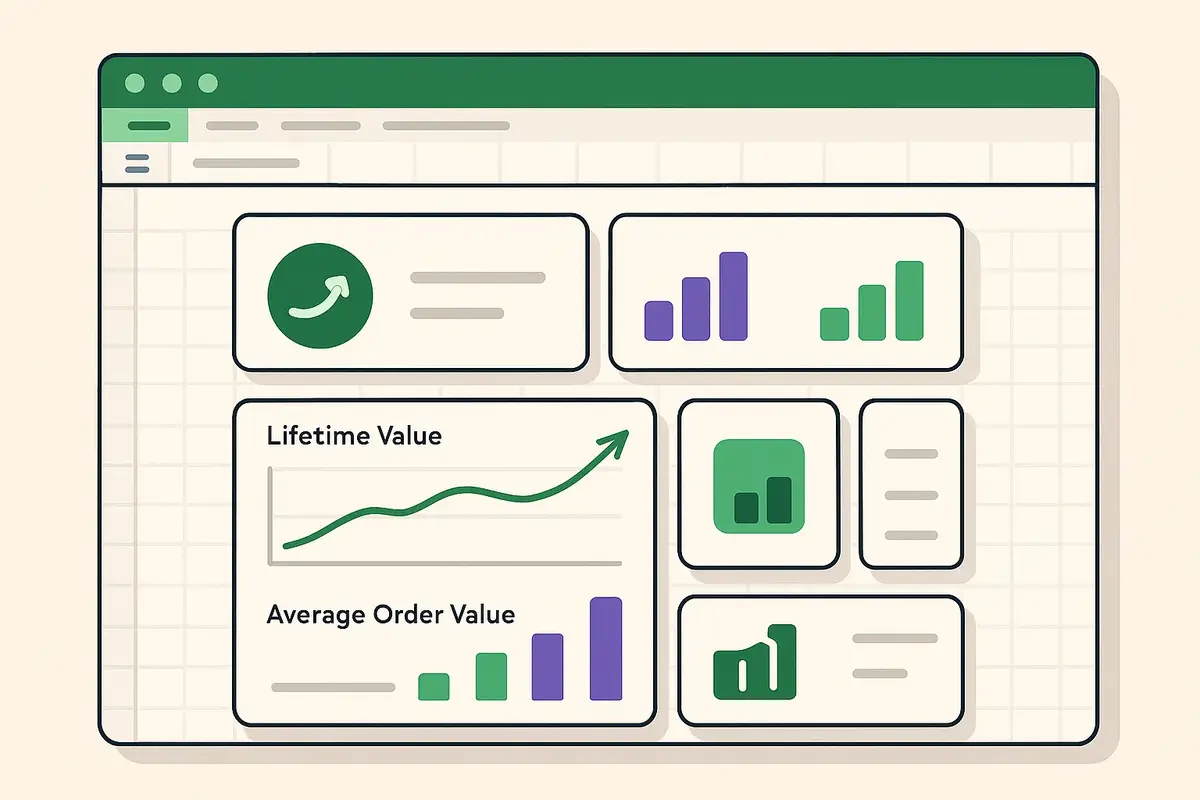Customer LTV & Cohort Analysis in Excel: No Code Required
Stop looking at total revenue. Cohort analysis reveals which customer acquisition months drive the most lifetime value. Learn to build cohort tables and LTV calculations in Excel for smarter marketing spend.

The Question That Changes Your Marketing Strategy
You spend $50K on Facebook ads in March and $50K on Google ads in April. Both drive 1,000 customers. Which was the better investment? You can't tell from first-month revenue alone. You need to track these cohorts over time: March Cohort (Facebook):- Month 1: $40K revenue (40 customers)
- Month 2: $12K (120 repeat orders)
- Month 3: $8K (80 repeat orders)
- 3-Month LTV: $60K / 1,000 = $60 per customer
- Month 1: $50K revenue (50 per customer)
- Month 2: $4K (40 repeat orders)
- Month 3: $2K (20 repeat orders)
- 3-Month LTV: $56K / 1,000 = $56 per customer
Building Cohort Analysis in Excel
Structure Your Customer Data
Need columns: Customer ID, Order Date, Order Value, First Purchase Date. Export from Shopify: Customers > Export. Use formula =MIN(OrderDate) to find each customer's first purchase date.

Create Cohort Assignment
Add column Cohort Month =TEXT(FirstPurchaseDate,"YYYY-MM"). This groups customers by acquisition month. All January 2024 customers = one cohort.

Calculate Months Since First Purchase
Add column: MonthsSince =DATEDIF(FirstPurchaseDate, OrderDate, "M"). Order from cohort's Month 0 = 0, Month 1 = 1, etc. This lets you track behavior over time.

Build Cohort Pivot Table
Pivot: Rows=Cohort Month, Columns=Months Since, Values=Sum of Order Value. This creates the classic cohort table showing revenue by cohort by month.

Calculate Cumulative LTV
For each cohort, cumulative LTV = sum across all months. Formula: =SUM(Month0:Month12)/CohortSize. Shows total value generated per customer over 12 months.

Calculate Repeat Purchase Rate
By cohort by month: =COUNTIFS(Cohort,ThisCohort,MonthsSince,ThisMonth)/CohortSize. Shows % of cohort still buying. Strong cohorts stay above 15% by Month 6.

Build LTV Projection Model
Use historical repeat rate to project future LTV. If 20% buy in Month 1, 15% in Month 2, project 12-month LTV even for new cohorts with only 3 months data.

The Key Metrics in Cohort Analysis
1. Month-0 AOV (First Purchase Value)
Higher is better, but not the whole story. Good: $75+ Concerning: Under $302. Month-1 Retention Rate
% of customers who buy again in Month 1. Excellent: 25%+ Good: 15-25% Average: 8-15% Poor: <8%3. Month-6 Cumulative LTV
Total revenue per customer after 6 months. Calculation: =SUM(M0:M6 revenue) / Cohort Size Target: 2-3x Month-0 AOV4. Cohort Half-Life
Months until 50% of repeat revenue is generated. Fast: 3-4 months (consumables, subscriptions) Slow: 8-12 months (durable goods, fashion)5. LTV:CAC Ratio
Lifetime value vs. customer acquisition cost. Healthy: 3:1 or better Workable: 2:1 Unsustainable: <2:1| Cohort Quality | M0 AOV | M1 Retention | M12 LTV | Characteristics |
|---|---|---|---|---|
| Exceptional | $100+ | 30%+ | $300+ | Brand advocates, high repeat, profitable at scale |
| Strong | $75-100 | 20-30% | $200-300 | Solid repeat behavior, sustainable growth |
| Average | $50-75 | 12-20% | $120-200 | Decent but needs optimization |
| Weak | $30-50 | 8-12% | $60-120 | Marginal, high CAC risk |
| Poor | <$30 | <8% | <$60 | One-and-done customers, unprofitable |
The Cohort Insight That Changes Everything
Common Mistakes to Avoid
Verification Checklist
- You have at least 6 cohorts with at least 6 months of tracking data
- You can identify your best-performing acquisition month and channel
- You know your average Month-1 and Month-6 retention rates
- You've stopped or reduced spend on channels that drive low-LTV cohorts